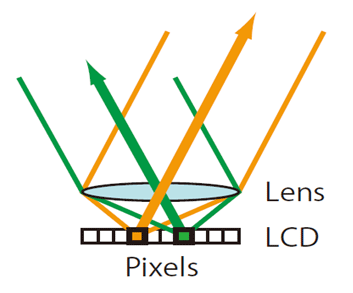The National Institute of Information and Communications Technology (NICT, President: Dr. Hideo Miyahara) has developed a cubic 3D display, called “gCubik,” which reproduces 3D images inside a 10cm-per-side cube viewable without special glasses. This time, all the six faces of the cube display 3D images, allowing users to see the display from every possible direction. Also, by adding special sensors, users can now interact with the inside images.
Home > Press Release > Cubic 3D Display Viewable from Every Direction Developed
At NICT, we are researching on communication technologies to capture and reproduce ultra-realistic presence among users. As well as developing the technology necessary for 3D displays without the aid of special glasses, we are studying and proposing possible application scenarios to spread the use of 3D displays in the near future. Our "gCubik", a cubic auto-stereoscopic display which has been designed as a tool to support communication among multiple users, is a graspable display born from this new concept (Fig. 1).
This time, all the six faces of the gCubik display 3D images are allowing users to see the display from every direction without the aid of special glasses. This realizes, for the first time, our conceptual idea about "the illusion of 3D images inside a cube". The previous prototype had only 3 faces and was mainly used to verify the validity of our proposed method for reproducing 3D scenes inside a cube. Based on this results, we devised a new design of the optical components (lens) characteristics and a new lens layout. The current 3D image is about 3 times brighter and it has 1.4 better resolution making it easier to see than before (Fig. 2). Moreover, by arranging the control circuit boards outside the display part, the display is now more compact. With a cube size of 10cm per side (and 950gr weight), we have succeeded in making it possible to grasp the 3D images with your own hands (Fig. 3). Furthermore, each face of the display includes a touch panel while speakers for posture and acceleration, and speakers are included inside. Therefore, users are allowed to have simple interaction with the 3D images displayed. This now makes it possible to develop applications and begin discussions towards using the display as a communication tool.
By allowing users to share 3D images instead of pictures, while developing this technology further, we expect to provide a new means for future communications. We plan to propose a new interaction paradigm, and develop applications, for multiuser collaborative tasks that exploit the concept of "Graspable 3D Images". Furthermore, we plan to make the display which is wireless, even more compact and improve its image quality in preparation for commercial applications.
“gCubik” will be exhibited at SIGGRAPH 2009 on August 3-7 in New Orleans, USA. (http:// www.siggraph.org/s2009). It can also be viewed at NICT Keihanna Research Labs (in Kyoto). Parties who are interested in it, please contact us at the following contact points:
Technical Explanation
Each face of the display uses integral photography, which is one of the various methods to display 3D images without special glasses (auto-stereoscopic). When viewing a real scene, humans see a different image with each eye, which depends on the distance and the different position of the eyes (binocular parallax). When we move our heads, we see different images (motion parallax). These are some of clues on how humans perceive depth (3D). Integral photography uses a tightly packed micro convex lens array to record distinct 'elemental' images, and when these images are again viewed through the same micro-lens array, they reproduce the 3D integrated image of the scene with both binocular and motion parallax. Our system utilizes the electronic integral photography which uses an LCD display, instead of the recorded photograph, to display the elemental images.
Integral photography makes use of the principle that convex lenses are designed so that parallel incoming light rays converge into its focal point. Conversely, all the ray lights coming from a light source at the focal point will come out of the lens as parallel rays in the direction of the line joining the light source with the lens principal point. For example as shown in Figure A, the lens color will appear orange as the one in the elemental image, when viewed from the direction of the orange arrow, and green when viewed from the direction of the green arrow.
By arranging and displaying appropriate elemental images on the LCD pixels corresponding to each lens, each screen of the display functions as a window where different views of the scene can be observed depending of the viewing angle. By using integral photography (IP), horizontal and vertical motion parallax for 3D images can be observed without special glasses. However, previous IP technology has the problem of restricting users to view the display from a frontal position, so IP can not be immediately used for the screens in our cubic display where acute viewing angles are necessary due to the screens arrangement and the free orientation of the display when manipulated by the users. During the development of the gCubik, we derived the necessary optical specifications for the micro-lens array to overcome this problem after a careful investigation of these technological problems, and developed algorithms necessary for rendering the 3D images. We are still exploring new technologies to improve the display.
Besides, auto-stereoscopic displays using lenticular lenses are more widely known than the ones that use integral photography, but they only provide horizontal motion parallax, a subset of the parallax provided by IP.



Technical Contact
Multimodal Communication Group
Universal Media Research Center
Roberto Lopez-Gulliver, Shunsuke Yoshida
Tel :+81-774-95-2666
Fax :+81-774-95-2647
E-mail: 





















Public Relations
Sachiko HIROTA
Public Relations Office
Strategic Planning Department
Tel:+81-42-327-6923
Fax:+81-42-327-7587
E-mail: 

























